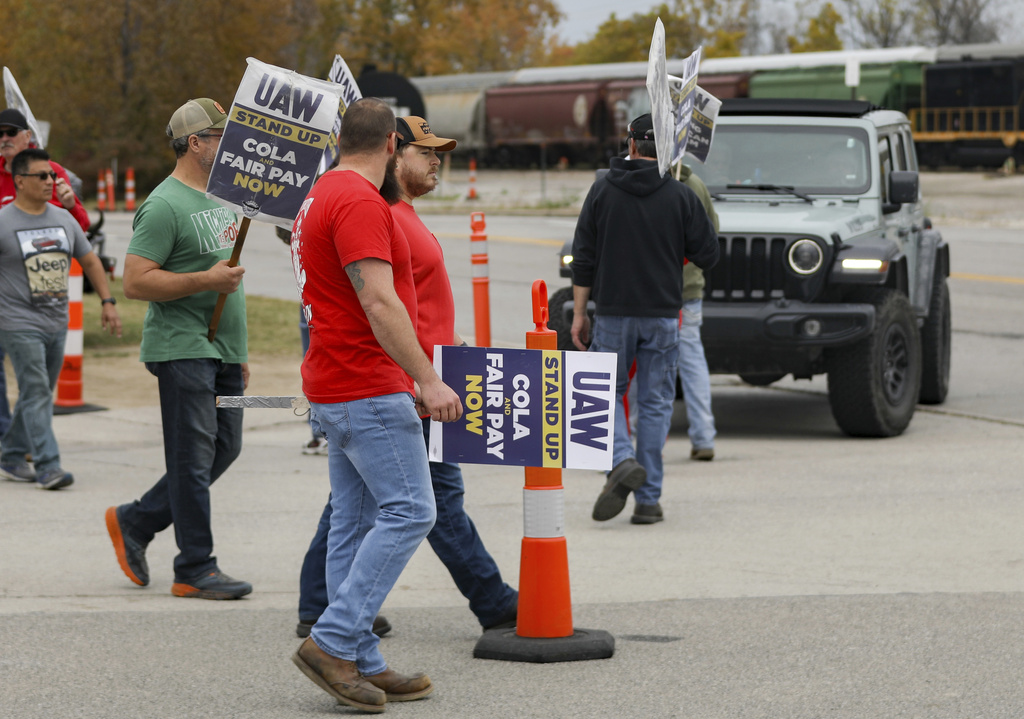The United Auto Workers union appears to be edging closer to a tentative contract agreement with Ford that would be critical to ending the union’s 6-week-old strikes against the three major Detroit automakers, two people with knowledge of the talks said Wednesday.
The people said the union made a counter-offer to Ford that proposes a 25% general wage increase over the life of a new four-year contract and said that negotiations on Tuesday extended well into Wednesday morning. Previously Ford, Stellantis and General Motors had all offered 23% pay increases.
A Ford deal would include cost-of-living pay increases that could lift the total pay raises above 30%, said the people, who asked not to be identified because they are not authorized to speak publicly about the talks. In addition, workers would still receive annual profit-sharing checks.
It’s still possible that the negotiations, despite the meaningful progress being made, could unravel. But if the UAW can reach a tentative agreement with Ford, it would be used as a model to seek similar contract settlements with GM and Stellantis. Typically, during past auto strikes, a UAW deal with one automaker has led the other companies to match it with their own settlements.
One of the people said there also was progress in the union’s talks with GM. But it was unclear whether any of the automakers had accepted the UAW’s counter-offer of 25% pay increases over four years.
The progress in the negotiations came after the union this week walked out at three factories that produce highly profitable pickup trucks and SUVs, adding them to the list of plants already on strike in a strategy to intensify pressure on the companies.
On Tuesday, about 5,000 workers at GM’s assembly plant in Arlington, Texas, walked out, halting production of truck-based SUVs that are huge profit makers for the company. A day earlier, the UAW’s president, Shawn Fain, had added 6,800 employees at Stellantis’ Ram pickup plant in Sterling Heights, Michigan.
Two weeks ago the union struck Ford’s largest and most profitable factory, the Kentucky Truck Plant in Louisville, where 8,700 workers make heavy-duty F-Series pickups and two large SUVs.
In all, about 46,000 workers have walked out at factories owned by the three companies in a series of targeted strikes that began Sept. 15. About 32% of the union’s 146,000 members at the automakers are now on strike and getting by on $500 per week in strike pay. The automakers have been laying off workers at other plants as parts shortages have cascaded through their manufacturing systems.
Todd Dunn, president of the UAW local at Ford’s Kentucky Truck Plant, said he was told by people within the union’s leadership that the company is nearing an agreement.
“I’ve heard they are moving the needle as aggressively as possible,” Dunn said in an interview Wednesday. “It’s very positive.”
The prospect of a breakthrough, he said, has raised the spirits of workers who are willing to stay out on strike to reach a deal despite hardships for some.
Dunn said he thinks the strike at his plant had nudged Ford along in the talks and could help yield the best contract he’s seen in 29 years with the company.
Neither the companies nor the union would comment on the talks Wednesday. The union’s counter-offer of a 25% wage increase over four years was reported earlier by Bloomberg News and the trade publication Automotive News.
Marick Masters, a business professor at Wayne State University in Detroit who studies labor issues, said it was not surprising that the union would be close to an agreement at this point in the talks.
“I think that Shawn Fain struck these plants at this particular time over the past week because he thought they would be near a deal and this would be the extra nudge to get something cemented,” Masters said. “When you look at the movement and the concessions, they’re getting smaller but moving closer to what the union wanted.”
When contract talks began in July, the union sought 40% pay raises over four years as well as the restoration of cost-of-living raises. The union had given up the cost-of-living increases in 2009 to help the companies survive the aftermath of the Great Recession.
The UAW also wants traditional defined-benefit pension plans restored for workers who were hired after 2007, an end to varying tiers of wages for UAW workers, pension increases for retirees and other benefits.
One key issue is whether to extend the national UAW contract to 11 U.S. electric vehicle battery factories. This would essentially ensure that workers there would be represented by the union.
All but one of these plants are joint ventures with South Korean battery makers. GM has agreed to this, but the other companies have balked, saying their joint venture partners must also agree.
GM CEO Mary Barra said Tuesday that the offer to bring the battery plants into the master union agreement was still open but that they would have to meet what she called “benchmark economics and also operating flexibility.”
Having union representation at the battery factories is a vital issue for the union because these plants will house many of the jobs of the future as the industry transitions away from gasoline vehicles. Workers who now make engines and transmissions at all three companies will need places to work as their plants are phased out.
Progress in the contract talks follows statements from Ford executives in the past two weeks that their offers, which exceeded those of their competitors, are at the limit of how much the company is willing to pay to settle the strikes.
All three companies have said they don’t want to absorb labor costs that are so high that they would force price increases and make their vehicles more expensive than those made by nonunion companies such as Tesla and Toyota.
A study this month by Moody’s Investor Service found that annual labor costs could rise by $1.1 billion for Stellantis, $1.2 billion for GM and $1.4 billion for Ford in the fourth year of the contract. The study assumed a 20% increase in hourly labor costs.
Wayne State’s Masters said the companies will have to cut other expenses or raise vehicle prices to cover the costs of a new contract. Prices, though, will be constrained by a competitive auto market, he said.
GM on Tuesday said it already is preparing for added labor expenses, taking out $2 billion in fixed costs by the end of 2024. It’s also looking at other ways to save.
The company said it lost $200 million in pretax earnings due to the strike in the third quarter, and it has lost another $600 million so far in the fourth quarter. After that it could lose as much as $200 million per week, not including the Texas plant closure or any further walkouts.
(AP)











